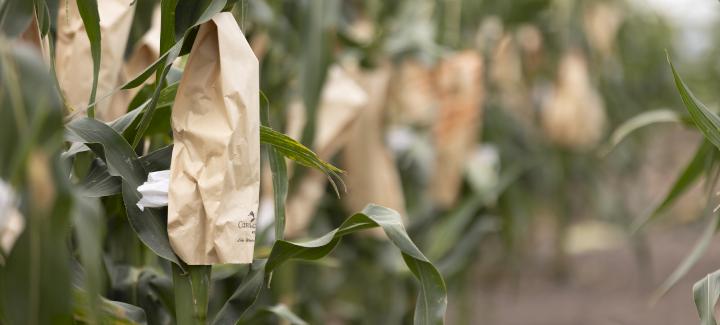
Stine® hybrid seed corn goes through an extensive process before it’s released for commercialization. In last week’s article, we explored what makes our corn breeding program more efficient than others in the industry, and the beginning stages of corn development at our nursery on the Stine Seed Farm. This week, we discuss new inbred development, which is another important step in our corn breeding program.
How are new inbreds developed?
“New inbreds are developed by making crosses between inbreds that have successfully completed the final stage of yield trials,” says Warren Stine, assistant director of corn research. “These crosses are made either in isolation blocks or in the nursery. Seed from these crosses is then shipped to our winter nursery in Guyana, where it is planted in late November and then self-pollinated, or ‘selfed.’”
Once the seed reaches Guyana, our team onsite will harvest the seed in February (Generation 1) and then plant it and self it again to harvest in May (Generation 2). This seed will be planted, selfed and harvested again in August (Generation 3) and then again in November (Generation 4). Each individual cross from the prior year, which originated on the Stine Seed Farm nursery in Adel, is now assigned a population number, and each ear harvested from that population is assigned a line number.
“Each generation of selfing drives a process of genetic recombination during which new characteristics start to segregate out,” says Stine. “After three generations of selfing, individual plants have an ear that is unique and stable enough to test yield.”
Each line (ear) will have some seed placed in an isolation block where it will be used as a female for crossing to make a test hybrid. The seed from the line (ear) not placed in the isolation block is shipped back to Adel, where it is selfed in the Adel nursery. The hybrid seed created in the Guyana isolation block are placed in Stine’s Pre-Elite testing program.
“Crosses made this year in Iowa will go to Guyana and spend all of 2024 there,” says Stine. “In 2025, the progeny and hybrid test seed from those crosses will return to Iowa. The hybrids go into the yield trial, and the inbreds go into the nursery for selfing.”
What are corn isolation blocks?
Corn isolation blocks are important to developing new corn inbreds. Essentially, they are fields that are isolated from outside sources of pollen. This ensures purity in the product, where no external source can pollinate the female inbreds. The fields are isolated either by date or space.
“We use isolation blocks to increase seed stock and create hybrid crosses and new population crosses,” says Stine. “These fields always have one male inbred serving as a pollen source. All female inbreds are required to be detasseled. Several thousand unique female inbreds can be used in a single isolation block.”
The detasseling process in isolation blocks is a critical step and requires daily walking for tassels until all female inbreds are completely detasseled. As these females are of varying maturities, the detasseling process can take several weeks. This year, on the Stine Seed Farm, we have roughly 207 acres split between 50 isolation blocks. Planting dates were April 28 to June 12. The blocks were planted in a six and two pattern, and we used 121,013 row tags, or about 19 miles worth of tags to mark inbreds.
Now that we’ve explored how inbreds are developed and used in our corn breeding program, next week we’ll focus on how hybrids and conventional seed corn advance through Stine corn yield trials and, eventually, to commercialization. Stay tuned for Part 3 next Thursday.
Related Articles
-

Use Stine’s XP® seed treatments to prevent early injury to your crops
December 2025 in Agronomy
-

Understanding Stine’s enhanced oil profile soybeans
December 2025 in Agronomy
-

Soil sampling sets the stage for spring
November 2025 in Agronomy
-

Corn production growth paves way for more high-performing Stine® hybrids
November 2025 in Agronomy



